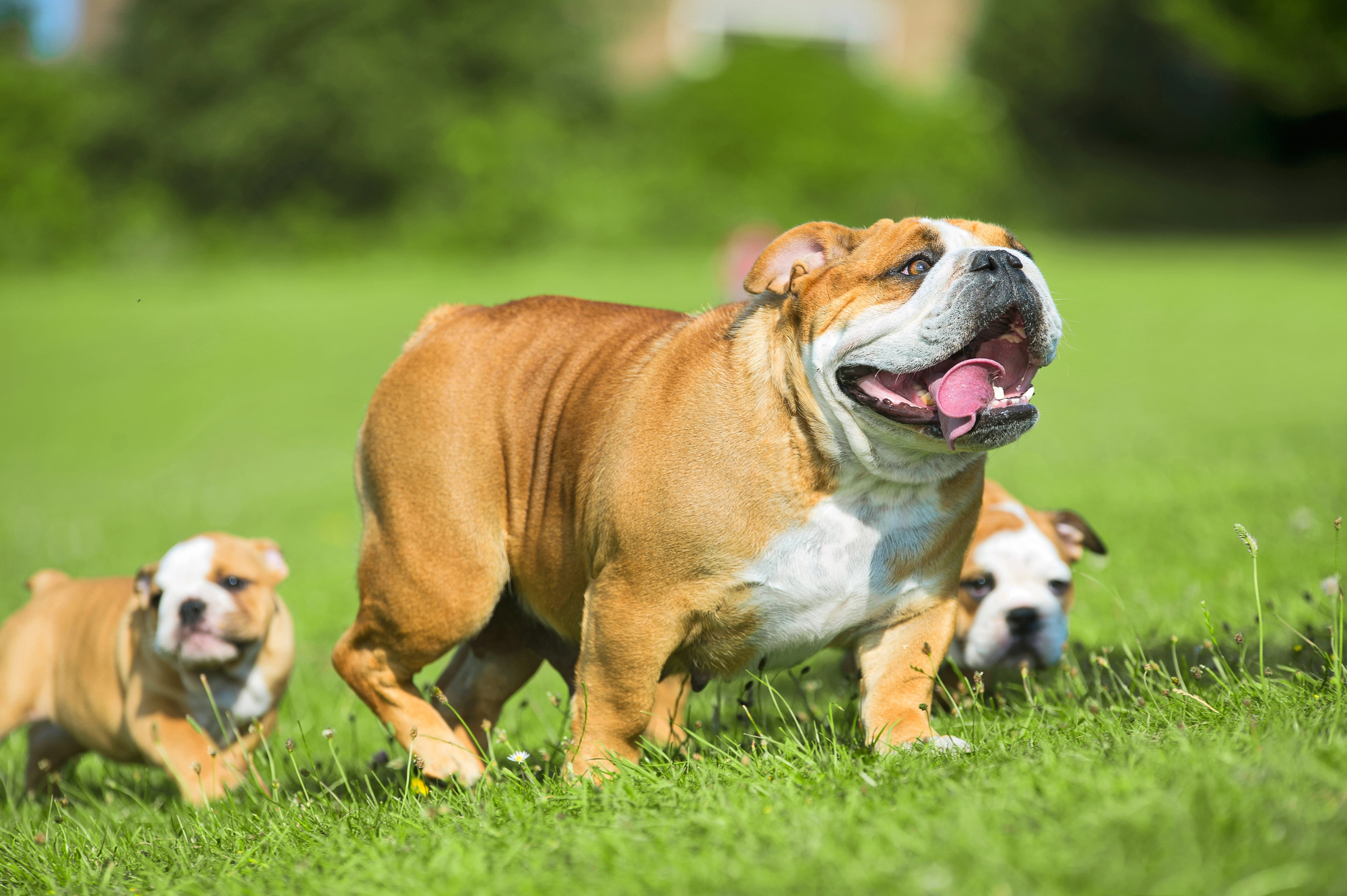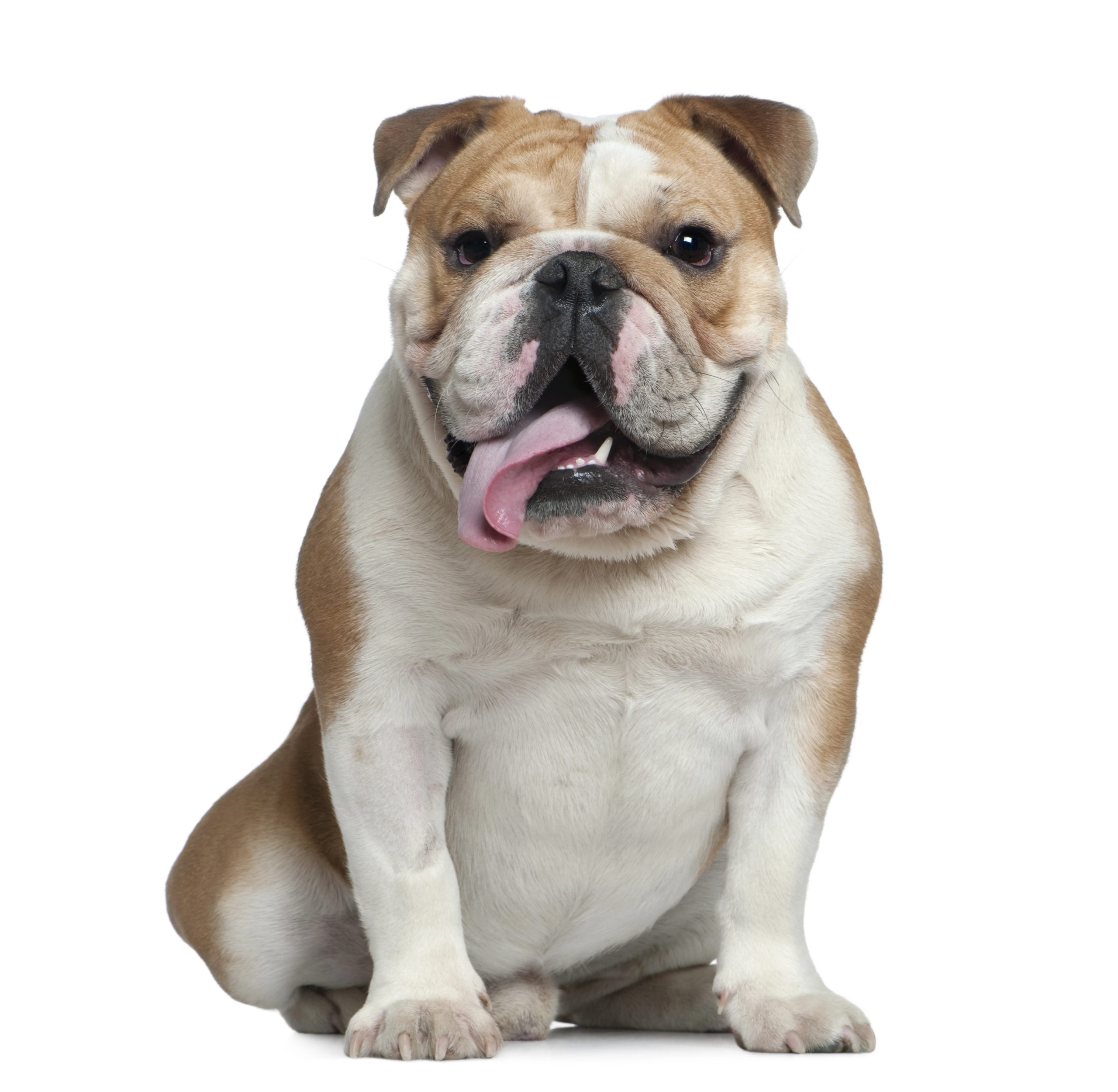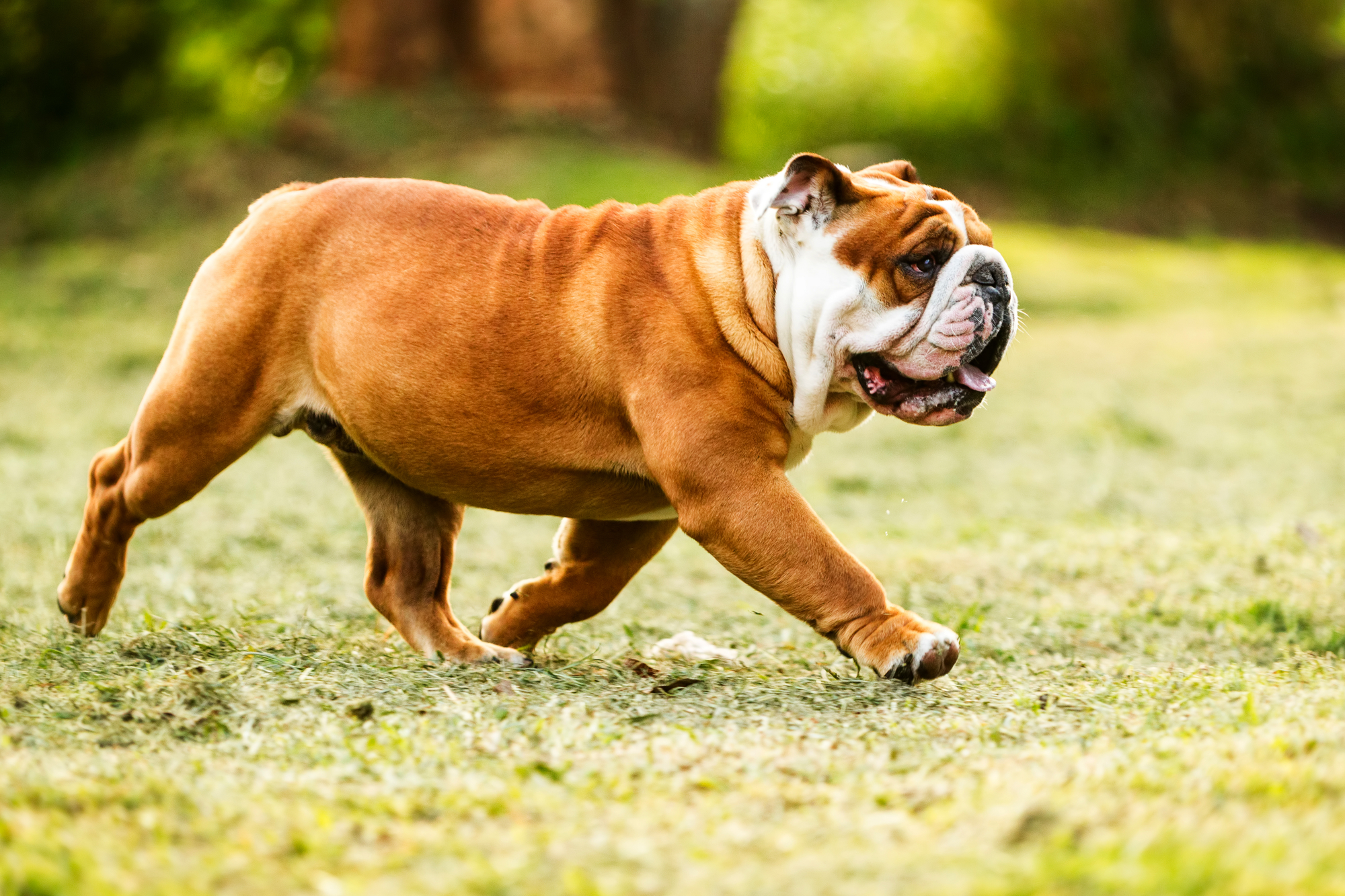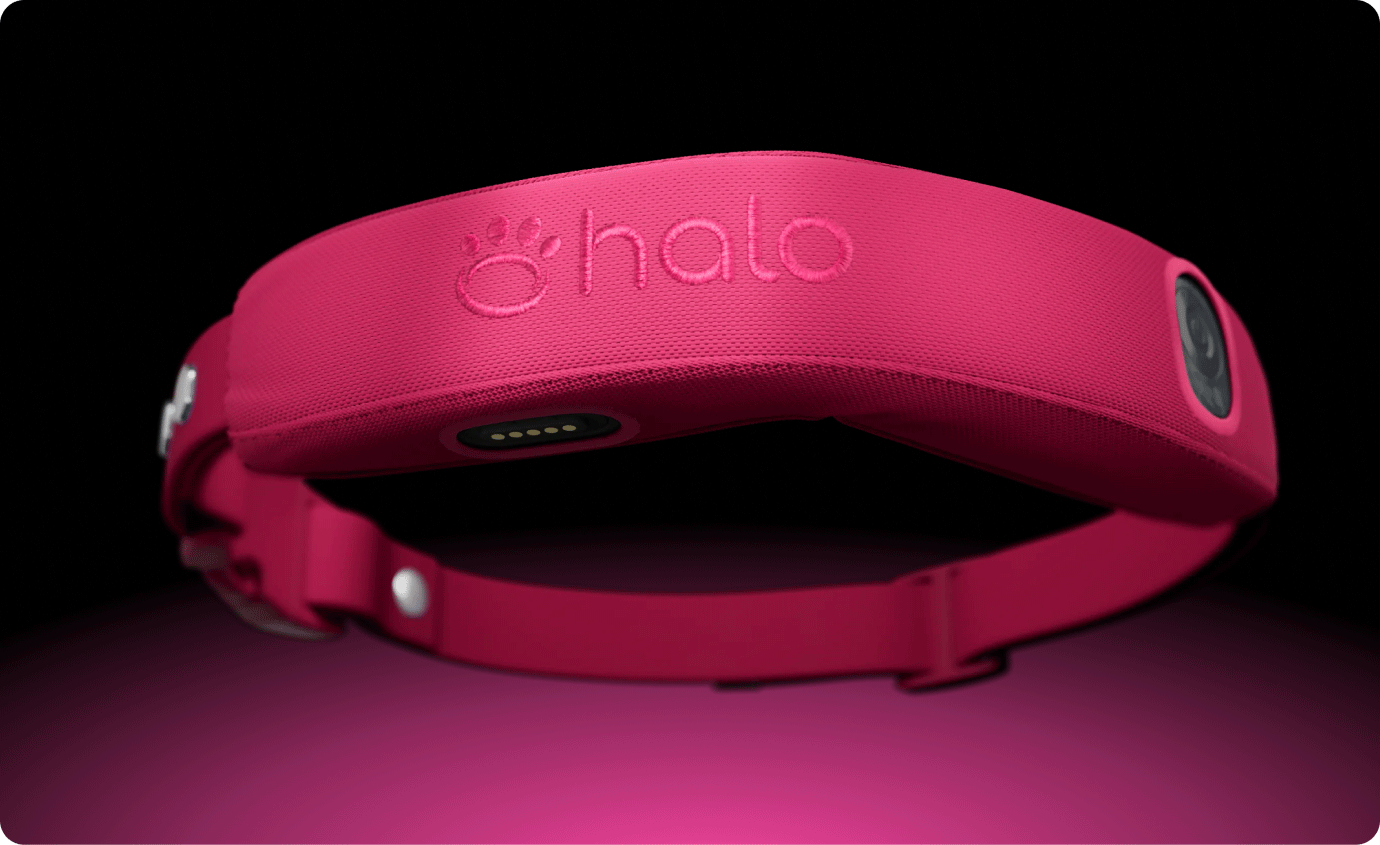Your Cart

Halo is backed by a 90-day satisfaction guarantee
Subtotal$0
Tax & Shipping Calculated at checkout
Total $0
Known for their distinctive wrinkled face and short, stocky build, bulldogs are a popular choice breed among dog lovers. Although their appearance may seem intimidating to some, bulldogs are typically gentle, affectionate and intelligent. Their calm demeanor and sometimes goofy antics make them a favored companion animal. This guide provides breed details highlighting the bulldog’s physical characteristics, nutrition needs and special considerations regarding grooming and exercise. It also provides insights into common health issues and training strategies to overcome this dog breed’s occasional stubborn streak.
Although their appearance may seem intimidating to some, bulldogs are typically gentle, affectionate and intelligent.

Male: Weight: 50 lbs; Height: 14-15 inches
Female: Weight: 40 lbs; Height: 14-15 inches
Yes
Generally good, but should be socialized early
Usually excellent family pets
Require consistent, positive reinforcement; females easier to train, males more stubborn
All-over brushing with a soft brush for 10 minutes 2-3 times a week
8-10 years
Tenacious, courageous, calm, goofy
Intelligent, friendly, dedicated, affectionate
Fawn, red, white, fallow, fawn and white, red and white, fawn brindle and white, fawn and brindle and red brindle
Adjustable; Fits most dogs

Male and female bulldogs have a distinctive face with a pushed-in nose, visible underbite and lots of loose, wrinkled skin. Their unusual face and head also feature small ears resembling rose petals because they fall backward, not forward, causing the top part to fall to the side. Droopy, often drooling jowls and striking coloring round out their unique appearance.
The bulldog’s short, smooth coat can be a wide array of colors, including fawn, red, white, fallow, fawn and white, red and white, fawn brindle and white, fawn and brindle and red brindle. The coat may also sport various markings, including a black face mask, black tips or white, piebald or ticked markings.
Although males and females share most physical characteristics, males are slightly larger and more muscular. Both sexes can grow to 14-15 inches tall, but males typically weigh 50 pounds or more, while females are approximately 40 pounds. The breed’s weight and relatively short stature make it a compact yet stout, medium-sized dog.
Bulldogs can be sweet and easygoing, but the males have a reputation for being stubborn. While females are often more affectionate and eager to please, males are prone to dominant behavior that makes them more challenging to train. However, pet parents can effectively train both sexes with consistency, patience and positive reinforcement. Early socialization is vital to ensure they learn to interact favorably with people and animals. Training your dog to stay inside a GPS dog fence is a great way to enjoy off leash time outdoors with your dog, while ensuring they are safe at all times.
Puppy training is highly recommended for bulldogs to help curb undesirable behaviors and develop good manners. Between 8-16 weeks, socialize your bulldog with other dogs and people in various environments and fun, stress-free situations. Also, get it used to being handled for grooming, especially cleaning the wrinkles on its face, which someone must do several times a week throughout its life.
Bulldogs love to chew, especially while teething, but they’ll chew their entire lives. During puppy training, teach them what’s okay to chew. Provide them with sturdy rubber toys for gnawing. If they’re nibbling something they shouldn’t, like your shoes, distract them and replace this item with their designated chew toys. When they chew on acceptable items, give them plenty of praise to positively reinforce this good behavior. While working with them on appropriate objects to chew on, also work with them on releasing what’s in their mouth on command.
By 6 months, you should have your bulldog puppy playing nicely with other dogs and chewing on appropriate toys. Continue basic obedience lessons with simple commands, such as “sit” and “stay,” working your way up to “drop it” and “leave it.” Because bulldogs have a strong grip when they bite down, it’s crucial to teach them the “drop it” command instead of forcibly taking things from them and potentially causing them to guard resources.
You should also be working with them on potty training through crate training. It’s an excellent time to begin exercising them, but only in cool temperatures. Because they have short muzzles with pushed-in noses, referred to as a brachycephalic breed, bulldogs have difficulty breathing on hot, humid days. Opt for exercising early morning or late evening to avoid the hotter parts of the day. If your bulldog starts panting excessively, cool it down with room-temperature water.
At the 1-year mark, your bulldog should have strong basic obedience skills and an exercise routine. Although it’s not a sporting or herding breed, you can pursue advanced training with your bulldog. It can take part in obedience, rally obedience and conformation training. If the weather permits, it can even do agility training.
Don’t forget to include mental stimulation, which is just as important as physical fitness. Note that bulldogs love the water but aren’t good swimmers because of how they’re built. You can create entertaining, supervised activities for them in a shallow kid’s pool, but put them in a life jacket anytime they’re around larger bodies of water, such as a river, lake or ocean.
Because bulldogs have such short, smooth coats, haircut styles are pretty much nonexistent, but they still shed. To remove loose hairs, brush them all over with a soft brush for about 10 minutes 2-3 times a week. Use a rubber curry brush first to help snag the dead hairs during heavier shedding periods.
Bulldogs don’t require frequent baths. If they become especially dirty or smelly, use a mild dog shampoo and rinse them thoroughly to prevent skin irritation. Take care not to get water in their ears or nose, which are both prone to infections.
Clean and dry their face wrinkles several times a week to prevent irritation and infection. Use a cotton ball dipped in peroxide to clean the wrinkles, then apply cornstarch to help dry these areas. However, you should never use either product near their eyes. You may also need to gently wipe wrinkles daily with a soft cloth to keep the area dry.
A bulldog’s ears can also accumulate dirt and wax, leading to infection. Use a high-quality, veterinarian-approved ear-cleansing solution to clean their ear canals, and gently wipe the interior of the ears with a cotton ball. Use a damp cloth to remove debris or discharge from their eyes to prevent infections. Trim their toenails about every 2 weeks to prevent discomfort, pain or difficulty walking.

Although bulldogs aren’t highly active, even short, moderate walks can cause overheating due to their short snouts. They can be highly prone to overheating, so spend summer afternoons indoors in an air-conditioned room.
Never leave your bulldog outdoors unattended or without water and shade. Pay attention to the dog’s breathing. If your bulldog begins breathing heavily, its tongue is hanging out farther than usual or the tongue has a bluish tint instead of the normal pink, soak the dog with cool water immediately.
Besides brachycephalic airway syndrome, bulldogs are susceptible to hip and elbow dysplasia and joint problems. Continuously monitor their skin for itching, redness or unusual lumps, as they’re prone to various skin allergies. Proper grooming, a healthy lifestyle and regular veterinary checkups are vital for a bulldog’s well-being. The National Bulldog Club of America also recommends regularly ordering a patella evaluation, tracheal hypoplasia radiograph evaluation and cardiac exam.
Your bulldog’s diet should be appropriate to its size, activity level and age — puppy, adult or senior — to ensure a complete, balanced nutrition program. Because this breed isn’t highly active, some are prone to becoming overweight. Watch your bulldog’s calorie intake, including treats used to aid in training, and weight level to ensure it maintains a healthy weight. Bulldogs are also vulnerable to digestive issues and gas, so smaller, more frequent meals can help prevent discomfort during digestion.
Many bulldogs are allergic to chicken. Some sources recommend high-quality dog foods containing beef or fish for this breed. Avoid foods containing artificial additives, excessive fillers, soy, corn or wheat. Choose a product with a moderate fat content to provide energy without additional calories that could promote obesity. To help promote healthy joints, choose foods with glucosamine and chondroitin.
If feeding a dry dog food, opt for a product with small kibbles to make eating and breathing easier for these flat-faced dogs. Talk to your vet if you need help choosing the right food and adjusting the portions to maintain your bulldog’s ideal weight.
As puppies, bulldogs often have boundless energy as they explore the world full of curiosity until they wear themselves out and need a nap. While adult bulldogs become much more laid-back and often prefer relaxing next to a human on the couch, they’re not lazy. This breed still enjoys walks and requires regular doses of moderate exercise to remain trim and physically fit.
Most sources recommend between 30 minutes and 1 hour of daily exercise, broken down into shorter 15-minute walks to prevent overexertion. Instead of walking during the heat of the day, take short walks when it’s cooler so they can get fresh air without overheating. They can also have play sessions indoors when it’s hot or humid to prevent respiratory distress. Bulldogs may enjoy a short game of fetch or tug-of-war and like interactive games that stimulate them mentally.
The miniature bulldog was an intentional crossbreed between the English bulldog and the smaller pug. According to some sources, this designer dog breed wasn’t much smaller than the standard size, at 12-17 inches in height and 25-30 pounds for females and 30-35 pounds for males. However, other sources say the toy bulldog’s average weight was just 15 pounds, making it much smaller. It appears there might have been multiple versions of a miniature bulldog with varying traits and sizes, but most sources indicate this breed is extinct due to multiple health issues.

Bulldogs tend to be heavy but relatively small, with moderate energy levels, so they’re well-suited to various living environments, including apartments. If you have a yard for them, ensure it offers plenty of shade, but don’t leave them unsupervised outdoors when it’s hot or humid.
They’re known to be loyal and form strong bonds with their humans, making them good breeds for families. However, some sources say they do better with older children versus younger ones. Like any dog, supervise interactions between your bulldog and smaller children to ensure everyone remains safe.
Bulldogs tend to be sociable, so they typically get along with other pets, including cats, especially if they’re socialized at a young age. However, they can have a strong prey drive, so supervise interactions with smaller pets. They may also display dominant behavior toward dogs of the same sex, so monitor attitudes when introducing this breed to a new canine companion.
Overall, bulldogs have a loving nature, and some even like to cuddle. They typically have a calm demeanor indoors, so you shouldn’t have any concerns over damage to your home except for chewing incidents during teething. Despite potential personality differences, both male and female bulldogs can make wonderful companions.
A bulldog’s loving disposition and strong bond with human family members usually extends to children, but some sources indicate they interact better with older children versus younger children. Because they’re quite stout and muscular, it’s advised to supervise interactions between bulldogs and children to ensure both feel comfortable and safe.
Bulldogs have moderate energy levels but are prone to obesity, so they need regular exercise to help them stay trim and healthy. Aim for 30 minutes to 1 hour of daily activity, made up of short 15-minute walks to avoid overheating when it’s warm outdoors. Indoor play and interactive games also keep them mentally stimulated and happy.
Bulldogs have short, smooth coats that require minimal styling, but they still shed. Brush them gently 2-3 times weekly to remove loose hairs, using a rubber curry brush during heavier shedding. Bathing often isn’t necessary, but when they’re dirty, use mild dog shampoo and rinse them thoroughly to prevent skin irritation. Pay special attention to their facial wrinkles, and clean and dry those regularly to prevent infection. Likewise, keep their ears clean with a veterinarian-approved cleansing solution, and trim their toenails every 2 weeks for comfort and mobility.
Bulldogs are generally sweet animals but can exhibit stubbornness during training, especially males. While females may be more eager to please, both sexes benefit from consistent, patient training. Early socialization is crucial for positive interactions. Start puppy training early to address any behavior issues, with a focus on obedience. Continue obedience training through adulthood to ensure ongoing positive behavior reinforcement. A GPS wireless dog fence is a great way to train your bulldog to stay close, while still giving them freedom to roam and play.
Bulldogs are prone to overheating due to their flat snouts, making even short walks risky in hot weather. They’re susceptible to brachycephalic airway syndrome, hip and elbow dysplasia and skin allergies. Yearly veterinary checkups are crucial, and the National Bulldog Club of America recommends regular evaluations for patella, tracheal hypoplasia and cardiac issues.
According to the American Kennel Club, bulldogs typically live 8 to 10 years. Factors influencing longevity include lifestyle choices, such as diet and exercise. Genetics and the quality of care, including regular veterinary checkups and preventive measures, can also impact the average lifespan of a bulldog.
Bulldogs typically get along with other dogs and pets, including cats, particularly if they’re properly socialized when they’re young. However, bulldogs can have a strong prey drive, so always supervise interactions with smaller pets. They may also display dominant behavior toward dogs of the same sex.
Bulldogs tend to be heavy but relatively small and have moderate energy levels, so they’re usually comfortable in any living environment, including apartments. Because they require limited daily exercise, you don’t need a large yard to keep them happy.
Male bulldogs can be stubborn when training, so it’s helpful if pet parents have some previous experience with dogs. Caring for their facial wrinkles also requires a bit of time and attention, so busy professionals may prefer a lower-maintenance dog. However, bulldogs require limited exercise and are happy to curl up with their humans and nap. Even with the extra grooming needs, bulldogs require less attention than many other highly active breeds.
Feed your bulldog a diet tailored to its size, age and activity level. Because this breed tends to have moderate energy levels and require limited exercise, the recommended feeding amounts on dog food packaging may be too high. Talk to your vet for personalized recommendations. Bulldogs tend to be allergic to chicken, so consider high-quality dog foods with beef, lamb or fish as the primary ingredient, and avoid products with excessive fillers or high-fat contents that can promote obesity.

Now that you know the important aspects of owning a bulldog, you’re well on your way to a long and beautiful friendship. If you are looking for a way to let your dog stay active outside while remaining safe, Halo Collar is a fantastic option. It is a wireless GPS fence with a convenient phone app that allows you to set up a safe perimeter at home or anywhere you go. You can also track your bulldog’s activity and Halo is a great training aid for puppies and adult dogs. Shop for your Halo Collar today.

Halo is backed by a 90-day satisfaction guarantee
Subtotal$0
Tax & Shipping Calculated at checkout
Total $0